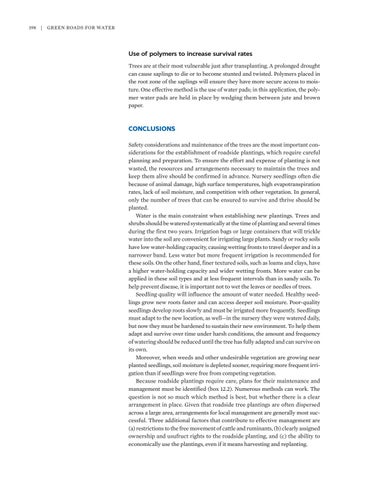198 | Green Roads for Water
Use of polymers to increase survival rates Trees are at their most vulnerable just after transplanting. A prolonged drought can cause saplings to die or to become stunted and twisted. Polymers placed in the root zone of the saplings will ensure they have more secure access to moisture. One effective method is the use of water pads; in this application, the polymer water pads are held in place by wedging them between jute and brown paper.
CONCLUSIONS Safety considerations and maintenance of the trees are the most important considerations for the establishment of roadside plantings, which require careful planning and preparation. To ensure the effort and expense of planting is not wasted, the resources and arrangements necessary to maintain the trees and keep them alive should be confirmed in advance. Nursery seedlings often die because of animal damage, high surface temperatures, high evapotranspiration rates, lack of soil moisture, and competition with other vegetation. In general, only the number of trees that can be ensured to survive and thrive should be planted. Water is the main constraint when establishing new plantings. Trees and shrubs should be watered systematically at the time of planting and several times during the first two years. Irrigation bags or large containers that will trickle water into the soil are convenient for irrigating large plants. Sandy or rocky soils have low water-holding capacity, causing wetting fronts to travel deeper and in a narrower band. Less water but more frequent irrigation is recommended for these soils. On the other hand, finer textured soils, such as loams and clays, have a higher water-holding capacity and wider wetting fronts. More water can be applied in these soil types and at less frequent intervals than in sandy soils. To help prevent disease, it is important not to wet the leaves or needles of trees. Seedling quality will influence the amount of water needed. Healthy seedlings grow new roots faster and can access deeper soil moisture. Poor-quality seedlings develop roots slowly and must be irrigated more frequently. Seedlings must adapt to the new location, as well—in the nursery they were watered daily, but now they must be hardened to sustain their new environment. To help them adapt and survive over time under harsh conditions, the amount and frequency of watering should be reduced until the tree has fully adapted and can survive on its own. Moreover, when weeds and other undesirable vegetation are growing near planted seedlings, soil moisture is depleted sooner, requiring more frequent irrigation than if seedlings were free from competing vegetation. Because roadside plantings require care, plans for their maintenance and management must be identified (box 12.2). Numerous methods can work. The question is not so much which method is best, but whether there is a clear arrangement in place. Given that roadside tree plantings are often dispersed across a large area, arrangements for local management are generally most successful. Three additional factors that contribute to effective management are (a) restrictions to the free movement of cattle and ruminants, (b) clearly assigned ownership and usufruct rights to the roadside planting, and (c) the ability to economically use the plantings, even if it means harvesting and replanting.







































